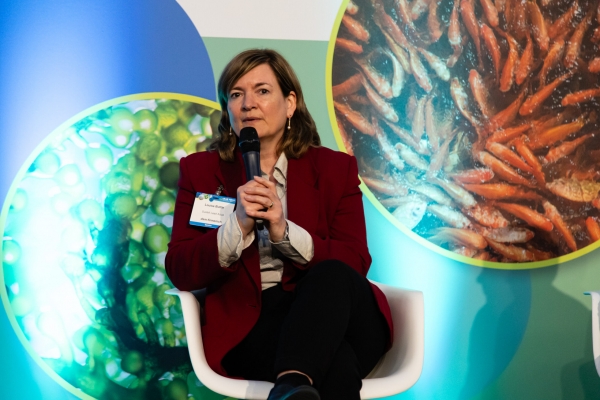Single cell proteins: A question of cost

The case for SCPs is compelling, built around their favorable nutritional profile, sustainability credentials and contribution to decoupling production from land use.
“SCPs are highly attractive for several reasons; they often contain high levels of essential amino acids, making them an invaluable ingredient in animal diets; they utilize less land and water compared to traditional protein sources, contributing to a notable reduction in greenhouse gas emissions and overall environmental impact; and they can be produced using industrial by-products and waste streams, promoting a circular economy and greatly enhancing resource efficiency,” Annette Berntsen, global category manager sustainable ingredients at Skretting, told FeedNavigator.
There are plenty of biotech companies circling this opportunity, including Calysta, Unibio, Novonutrients, Arbiom and Enifer. However, according to an industry source, most SCPs are at pilot scale or just beyond, with just one or two being produced commercially scale.
One that has made it to market is Calysta’s FeedKind Pet protein, which is approved for use in pet foods in the EU and is the star ingredient in Dr Clauder’s Trainee Snack Cultivated Protein - a dog treat that launched in Europe in May.

Potential in pet food and aqua feed
Pet food is one of the most promising applications for SCPs, along with aqua feed.
“In our labs, we are consistently producing an ingredient with an amino acid content of 70%. Realistically, therefore, we are looking at feed applications in which it will provide a small proportion of energy in a non-carnivorous diet, such as pet food or poultry, or a high proportion of energy in a carnivorous diet, such as salmon or shrimp feed,” John Hays, vice president of commercial and sales at Deep Branch, whose SCP, Proton, is produced via gas fermentation technology.
Simo Ellilä, CEO of Enifer, a Finnish producer of mycoprotein, agreed that realizing the potential of SCPs is about finding the right applications, and said that this can vary between different SCPs.
“It’s a matter of finding the best possible use cases for each SCP; there can be significant differences between proteins of fungal origin and bacterial origin and even within these categories,” he said.
For example, he said that his company’s SCP, PEKILO, contains a lot of beta-glucan fiber, which has health-promoting benefits across many species, as well as other interesting components such as nucleotides and spermidine.
“We’ve already shown excellent results for our ingredient in salmon and shrimp feeding trials, and are currently focusing on pet trials,” he noted.
Practical challenges
The demand from aquafeed producers is clearly there. Skretting makes no secret of its desire to incorporate sustainable novel ingredients into its feed formulations to expand its raw material basket, meet sustainability goals and reduce dependence on traditional protein sources like fishmeal and soy.
However, the company is also pragmatic about the challenges that need to be overcome in order for it - and the wider feed industry - to adopt SCP.
“Scaling up novel ingredients involves overcoming significant barriers, such as production complexities, high initial capital investments and rigorous testing protocols,” said Berntsen.
She continued: “Achieving economies of scale to make SCPs cost-competitive with conventional proteins remains a significant hurdle. The production processes for SCPs are complex, involving advanced fermentation technologies that require substantial initial investment in infrastructure.”
She added that setting up mass production facilities necessitates expertise in bioprocessing and large-scale microbial cultivation, which is still in its infancy compared to traditional protein sources, saying: “The cost of raw materials, energy and labor in these high-tech facilities can be prohibitive without substantial financial backing and strategic scaling. Thus, companies must navigate the challenge of high production costs while striving to increase efficiency and reduce overall expenses to make SCPs a viable alternative on a commercial scale.”
Ellilä agreed production cost is a major hurdle to the adoption of SCP.
“Production of SCPs is capital intensive, because you need to build factories with a lot of steel tanks, pipes, and valves. The bigger the factory, the cheaper the production can be thanks to economies of scale. However, it is extremely difficult for start-ups to finance factories costing hundreds of millions.”
This, he said, has created a “chicken and egg situation.”
“Companies need sales to improve traction to investors, in order to secure capital for large scale factories with better economics, but feed and pet food companies want to see production at scale and at lower price points,” Ellilä said.
Hays said what the SCP industry needs is for feed producers to “put their money where their mouth is.”
“Feed producers want an alternative to soy, and they love the concept of using green hydrogen as it reduces their carbon footprint. But they love the price of soy, so they have this conundrum where they only want to engage with SCP if it is at a price point that doesn’t affect their bottom line. Soy has large economies of scale and subsidization, and we will need customer and industry to be supportive until we can achieve our economies of scale to make SCP competitive.”
There is clearly a disconnect between the cost of SCPs and the price the industry is willing to pay - but how can this gap be bridged?

Collaboration and carbon footprint data key
Skretting’s belief is that long-term partnerships are the key to successful scale-up.
“Besides fostering innovation and sustainability by integrating the expertise and resources of diverse stakeholders, from ingredient suppliers to end consumers, they [partnerships] also help distribute the challenges and investments, making it more feasible to achieve economies of scale and reduce costs,” said Berntsen.
She confirmed that Skretting has already established “robust collaborations” with several innovative startups to “explore and enhance sustainable novel ingredients” and is continuing to scout the market for partners.
“A sustainable ingredient must have a suitable nutritional profile, proven market demand and acceptance, competitive cost, and scalability - which is often related to availability of feedstock. The supplier must aim to possess GMP+ quality certification level, demonstrate financial robustness, represent a balanced competent mix of skills, and have a clear purpose and vision,” she added.
Hays, meanwhile, would like to see the introduction of pricing mechanisms in the market to level to level up the playing field with traditional feed.
“We can get the carbon footprint of our protein ingredient below 1.5 kg of CO2 per kg of product, and we are being asked to price competitively against something that has a carbon footprint of 10+ if you factor in land-use change. So, we can quantify our value in carbon savings, but fundamentally, the problem is further down the value chain as customers do not make decisions based on CO2 footprint. If there were pricing mechanisms that took carbon footprint into account, our storyline would become much cleaner and easier.”















